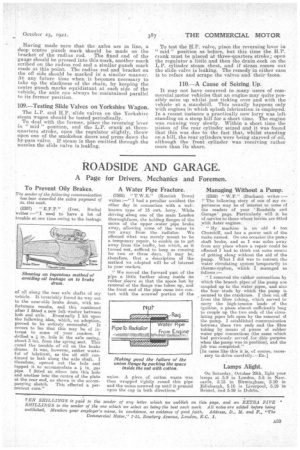ROADSIDE AND GARAGE.
Page 29

If you've noticed an error in this article please click here to report it so we can fix it.
A Page for Drivers, Mechanics and Foremen.
To Prevent Oily Brakes. The sender of the follouing communication has been awarded the extra payment of 5s. this week.
(2307) " E.F.P." (Ieer, Bucks) writes :—" I used to have a lot of trouble at one time owing to the leakage of oil along the rear axle shafts of my vehicle. It invariably found its way out to the near-side brake drum, with unfortunate results, and this continued after I fitted a new felt washer between hub and axle. Eventually I hit upon the following idea, which, on adoption, proved to be entirely successful. It occurs to me that this may be of intenest to some of your readers. I -drilled a in. hole in the axle casing, about 3 ins, from the spring seat. This cured the trouble of oil on the brake drums. It was, however, rather wasteful of lubricant, as the oil still continued to leak along the axle shaft. I therefore, opened out the hole and tapped it to accommodate a in gas pipe. I fitted an elbow into this hole and another into the centre of the plate at the rear end, as shown in the aecom
panying sketch. This effected a permanent cure."
A Water Pipe Fracture.
(2308) " T.W.E." (Kentish Town) writes :—" I had a peculiar accident the other day in connection with a wellknown type of 15 cwt. lorry. While driving along one of the main London thoroughfares, the holding Ranges of the union of the upper ,water'pipe broke away, allowing some of the water to run away from the radiator. We effected what was merely meant to be a temporary repair, to enable us to get away from the traffic, but which, as it turned Out, sufficed to keep us running for two or three days. It may Ise, therefore, that a description of the method we adopted will be of interest to your readers.
!' We moved the forward part of the pipe a little further along inside its rubber sleeve so that the space lost by removal of the flange was taken up, and the front end of the pipe came into contact with the screwed portion of the union. A piece of cotton waste was then wrapped tightly round this pipe and the union screwed up until it pressed upon the cup in both directions," Managing Without a Pump.
(2309) " W.F." (Durham) writes':' The following story of one of my experiences may be of interest to some of the readers of your ' Roadside and Garage' page. Particularly will it be of service to those whose lorries are fitted with Aster engines.
"My machine is an old 4 ton Churchill, and has a power unit of the make named. On one occasion the pumn shaft broke, and as I was miles away from any place where a repair could be effected I had to think out some means of getting along without the aid of the pump. What I did was to convert the wafer circulating system temporarily to thermo-syphon, which I managed as follows:—
" I removed the rubber connections by which the branch pipes -of the pump are coupled up to the water pipes, and also the four studs by which the pump is secured to the crankcase. I then cut off from the fibre tubing-, which served to carry the high-tension leads of the ignition, a piece almost sufficiently long to couple up the two ends of the circulating pipes left open by-the removal of the pump. I established communication between these two ends and the fibre tubing by means of pieces of rubber water pipe" connections (the same which had previously served for this purpese when the pump was in position), and the job was completed."
[In cases like this it is of course, necessary to drive carefully.—ED.] Lamps Alight.
On Saturdayl October 29th, light your lamps at 5.9 in London, 5.6 in Newcastle, 5.15 in Birmingam, 5.10 in Edinburgh, 5.16 in Liverpool, 5.19 in Bristol, and 5.59 in Dublin.






























